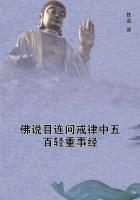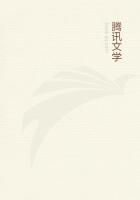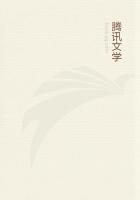The sextant, which is the instrument universally used at sea, was gradually evolved from similar instruments used from the earliest times. The object of this instrument has always been to find the angular distance between two bodies--that is to say, the angle contained by two straight lines, drawn from those bodies to meet in the observer's eye. The simplest instrument of this kind may be well represented by a pair of compasses. If the hinge is held to the eye, one leg pointed to the distant horizon, and the other leg pointed to the sun, the position of the two legs will show the angular distance of the sun from the horizon at the moment of observation.
Until the end of the seventeenth century, the instrument used was of this simple kind. It was generally a large quadrant, with one or two bars moving on a hinge,--to all intents and purposes a huge pair of compasses. The direction of the sight was fixed by the use of a slit and a pointer, much as in the ordinary rifle.
This instrument was vastly improved by the use of a telescope, which not only allowed fainter objects to be seen, but especially enabled the sight to be accurately directed to the object observed.
The instruments of the pre-telescopic age reached their glory in the hands of Tycho Brahe. He used magnificent instruments of the simple "pair of compasses" kind--circles, quadrants, and sextants. These were for the most part ponderous fixed instruments of little or no use for the purposes of navigation.
But Tycho Brahe's sextant proved the forerunner of the modern instrument. The general structure is the same; but the vast improvement of the modern sextant is due, firstly, to the use of the reflecting mirror, and, secondly, to the use of the telescope for accurate sighting. These improvements were due to many scientific men--to William Gascoigne, who first used the telescope, about 1640; to Robert Hooke, who, in 1660, proposed to apply it to the quadrant; to Sir Isaac Newton, who designed a reflecting quadrant;and to John Hadley, who introduced it.
The modern sextant is merely a modification of Newton's or Badley's quadrant, and its present construction seems to be perfect.
It therefore became possible accurately to determine the position of a ship at sea as regarded its latitude. But it was quite different as regarded the longitude that is, the distance of any place from a given meridian, eastward or westward. In the case of longitude there is no fixed spot to which reference can be made. The rotation of the earth makes the existence of such a spot impossible. The question of longitude is purely a question of TIME. The circuit of the globe, east and west, is simply represented by twenty-four hours. Each place has its own time.
It is very easy to determine the local time at any spot by observations made at that spot. But, as time is always changing, the knowledge of the local time gives no idea of the actual position; and still less of a moving object--say, of a ship at sea. But if, in any locality, we know the local time, and also the local time of some other locality at that moment--say, of the Observatory at Greenwich we can, by comparing the two local times, determine the difference of local times, or, what is the same thing, the difference of longitude between the two places.
It was necessary therefore for the navigator to be in possession of a first-rate watch or chronometer, to enable him to determine accurately the position of his ship at sea, as respected the longitude.
Before the middle of the eighteenth century good watches were comparatively unknown. The navigator mainly relied, for his approximate longitude, upon his Dead Reckoning, without any observation of the heavenly bodies. He depended upon the accuracy of the course which he had steered by the compass, and the mensuration of the ship's velocity by an instrument called the Log, as well as by combining and rectifying all the allowances for drift, lee-way, and so on, according to the trim of the ship; but all of these were liable to much uncertainty, especially when the sea was in a boisterous condition. There was another and independent course which might have been adopted--that is, by observation of the moon, which is constantly moving amongst the stars from west to east. But until the middle of the eighteenth century good lunar tables were as much unknown as good watches.
Hence a method of ascertaining the longitude, with the same degree of accuracy which is attainable in respect of latitude, had for ages been the grand desideratum for men "who go down to the sea in ships." Mr. Macpherson, in his important work entitled 'The Annals of Commerce,' observes, "Since the year 1714, when Parliament offered a reward of 20,000L. for the best method of ascertaining the longitude at sea, many schemes have been devised, but all to little or no purpose, as going generally upon wrong principles, till that heaven-taught artist Mr. John Harrison arose;" and by him, as Mr. Macpherson goes on to say, the difficulty was conquered, having devoted to it "the assiduous studies of a long life."The preamble of the Act of Parliament in question runs as follows: "Whereas it is well known by all that are acquainted with the art of navigation that nothing is so much wanted and desired at sea as the discovery of the longitude, for the safety and quickness of voyages, the preservation of ships and the lives of men," and so on. The Act proceeds to constitute certain persons commissioners for the discovery of the longitude, with power to receive and experiment upon proposals for that purpose, and to grant sums of money not exceeding 2000L. to aid in such experiments. It will be remembered from what has been above stated, that a reward of 10,000L. was to be given to the person who should contrive a method of determining the longitude within one degree of a great circle, or 60 geographical miles; 15,000L.
within 40 geographical miles; and 20,000L. within 30 geographical miles.














